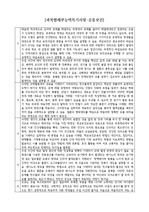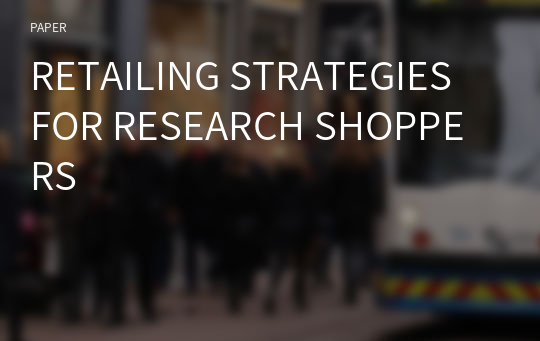RETAILING STRATEGIES FOR RESEARCH SHOPPERS
* 본 문서는 배포용으로 복사 및 편집이 불가합니다.
서지정보
ㆍ발행기관 : 글로벌지식마케팅경영학회(GFMC)
ㆍ수록지정보 : GFMC Session1
ㆍ저자명 : Wooyong Jo, Jikyung (Jeanne) Kim, Jeonghye Choi
ㆍ저자명 : Wooyong Jo, Jikyung (Jeanne) Kim, Jeonghye Choi
영어 초록
The research shopping involves making use of multiple channels for a single shopping incident, such as searching from one channel and buying from another (Neslin et al. 2006, Neslin and Shankar 2009, Verhoef, Neslin and Vroomen 2007). This is an opportunistic behavior on the side of the consumers, and may result in an unfair advantage of the retailers in one channel consumers choose to purchase from. For instance, consumers may browse a product in a brick-and-mortar store, making use of the retail space and sales assistance, and proceed to buy online from another retailer which offers lower price. This is called a “showrooming” behavior (when focusing on the consumer), or channel-free riding (when focusing on the business) (Mehra, Kumar, & Raju 2013, Van Baal & Dach 2005). Offline retailers are wary of this phenomena that may lead to higher costs and lower sales, and attempt to discourage it (Rapp et al. 2015). For instance, Borders and Circuit City, the former US national chains with a substantial offline market presence, went out of business presumably due to the showrooming phenomenon (Gustin, 2012; Passariello, Kapner, & Mesco 2014). However, recent studies show that research shopping across multiple channels within one company can be managed and contributes to firm profitability in the long run (Verhoef, Kannan, & Inman 2015, Zheng et al. 2016). Kumar & Venkatesan (2005) reveal that consumers who uses multiple channels are the ones with greater customer lifetime value and with less churn intention (Blattenberg, Malthouse, & Neslin 2009, Stone, Hobbs, & Khaleeli 2002). Neslin & Shankar (2009) suggest a practical discussion on market strategy in which customers who visited offline stores can be encouraged to repeat-purchase or to foster brand involvement by maintaining contact in another channel (e.g., email newsletter). It is particularly desirable to lure online consumers to an offline site, since they tend to make greater amount of purchases in a brick-and-mortar store (Ansari, Mela, & Neslin 2008). In the age of effortless access to and switching among a plethora of channels by consumers, it is critical for a business to understand and make best of the situation. In this regard, understanding consumers in terms of who are more likely to display research shopping tendency is crucial. Depending on whether a person tends to do research shopping, business should suggest and offer different channels for different purposes (Verhoef, Kannan, & Inman 2015, Zheng et al. 2016). For instance, those with high tendency to research shop can be approached in one channel, and nudged to another for purchasing. Those with low tendency should be directed to the final purchasing channel. With this in mind, we aim to investigate research shopping behaviors and individual covariates of these shoppers using individual-level responses. We conducted an online survey in France during September 2014 in cooperation with an anonymous global marketing research firm. The survey focused mainly on exploring customers’ shopping behavior in the apparel industry, as customers’ research shopping behaviors are salient in this industry because of its experiential attributes (Girard, Silverblatt, & Korgaonkar, 2002; Klein, 1998), while traditional patterns of purchasing using only one channel is also prevalent. After a discussion with the research firm about the French apparel industry and main customers’ demographics, we restricted the respondent pool to those between the ages of 25 and 54 who have abundant experience and an active role in apparel shopping. Responses from a total of 400 participants were used in the analyses. The dataset includes individual-level shopping characteristics, demographic information, and the extent of their research shopping behavior. Specifically, each customer was asked about their apparel shopping history (purchase frequency and expenditures on apparel) over the last three months for both offline and online retailers. In addition, demographic information such as gender, age, and educational background were asked. Using multiple questions, we captured shopper’s shopping traits, such as deal-proneness, quality-consciousness, and the degree of their shopping budget flexibility. To explore the individual characteristics of research shoppers, we modeled the probability of being a research shopper using a logistic regression model. From our modeling results, we suggest two notable findings. First, customers’ qualityconsciousness significantly increases their research shopping behavior, while their deal-proneness exerts little to no influence. We conclude this is due to extensive and systematic search tendency shared by quality-conscious customers, based on previous findings in the literature. That is, quality-consciousness induces customers to search carefully across multiple channels to check on multiple quality dimensions of the options at hand, and possibly discover other similar options that may maximize their satisfaction (Lysonski, Durvasula, & Zotos 1996, Sprotles & Kendall 1986, Wesley, LeHew, & Woodside 2006). However, deal-proneness is not associated with research shopping behavior presumably because the one dimension that these customers value (i.e., price) can be easily searched in one channel—the online channel. The literature supports this finding, since studies show that deal-prone customers tend to shop more online (Close & Kukar-Kinney 2010, Devaraj, Fan, & Kohli 2002, Zhou, Dai, & Zhang 2007). We also find that the association between quality-consciousness and research shopping behavior is more pronounced when the shoppers are flexible with their shopping budget. That is, when shoppers are both quality-conscious and willing and able to consider other options or additional items beside the one they have originally planned before shopping, their research shopping tendency is enhanced. We explain that this is because consumer behaviors and decisions are made upon limited resources (e.g., time, effort, and money), and that customers with flexible resources are more likely to extend and manage their choice set (Maity, Dass, & Malhotra 2014, Malhotra 1982). These consumers do not refrain from including options that are better yet more expensive, as they can afford the superior option that suits their tastes (Becker, 1965; Ghose & Han, 2011), and without the fear of creating regrets due to discovering unaffordable options (Lenton, Fasolo, & Todd 2008). We expect our work on research shopping to provide insights to both researchers and practitioners, as today’s multi-channel environment provides opportunities for businesses to manage their customers strategically over several channels they are present in. Therefore, the research is expected to be a useful reference for understanding multi-channel shoppers for the academics, and a valuable guide to retail firms that aim to not only cope with the multi-channel environment but to become a true omni-channel player.참고 자료
없음"GFMC Session1"의 다른 논문
 FAST AND SLOW FASHION BRANDS IN DEVELOPING SUSTAINABLE ..6페이지
FAST AND SLOW FASHION BRANDS IN DEVELOPING SUSTAINABLE ..6페이지 “WHAT IF A CELEBRITY AND A BRAND CO-CREATE A NEW COLLEC..7페이지
“WHAT IF A CELEBRITY AND A BRAND CO-CREATE A NEW COLLEC..7페이지 THE INSTAGRAM’S STRATEGY IN ENGAGING THE CUSTOMER’S LOY..3페이지
THE INSTAGRAM’S STRATEGY IN ENGAGING THE CUSTOMER’S LOY..3페이지 THE PARTICULARITIES OF NEW PRODUCT DEVELOPMENT IN THE T..5페이지
THE PARTICULARITIES OF NEW PRODUCT DEVELOPMENT IN THE T..5페이지 THE LONE CHOCOLATE BAR: THE INFLUENCE OF PERCEIVED SCAR..6페이지
THE LONE CHOCOLATE BAR: THE INFLUENCE OF PERCEIVED SCAR..6페이지 ADS AS WORKS OF ART: MEASURING ADVERTISING IMMERSION3페이지
ADS AS WORKS OF ART: MEASURING ADVERTISING IMMERSION3페이지 ECONOMIES OF SMALL: NICHE STRATEGIES AND SUCCESS FACTOR..8페이지
ECONOMIES OF SMALL: NICHE STRATEGIES AND SUCCESS FACTOR..8페이지 THE INFLUENCE OF ONLINE CUSTOMER REVIEWS ON RETAILERS' ..6페이지
THE INFLUENCE OF ONLINE CUSTOMER REVIEWS ON RETAILERS' ..6페이지 IS THE ARTIFICATION PROCESS PERCEIVED BY FINAL CONSUMER..6페이지
IS THE ARTIFICATION PROCESS PERCEIVED BY FINAL CONSUMER..6페이지 THE ODD EVEN PRICE PARADOX IN THE FASHION LUXURY SECTOR6페이지
THE ODD EVEN PRICE PARADOX IN THE FASHION LUXURY SECTOR6페이지


























